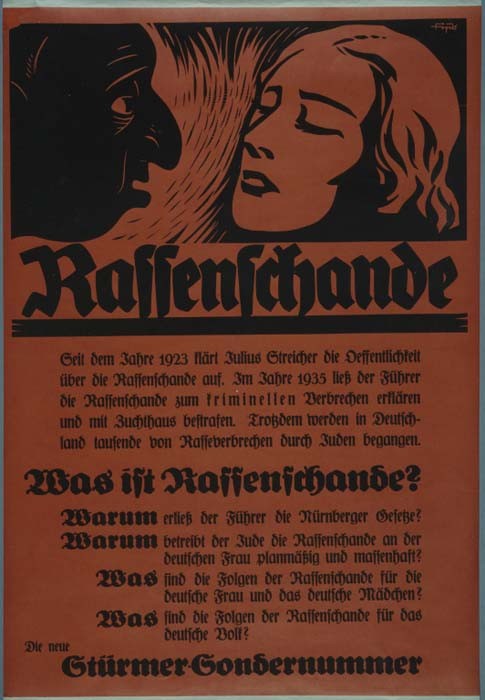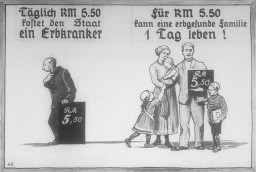
What were some similarities between racism in Nazi Germany and in the United States, 1920s-1940s?
The meanings of “race” and “racism” have varied over time and in different political, social, and cultural settings. Nazi racism and American racism are distinct and complex topics. This discussion question focuses on the history of racial antisemitism in Germany and its relationship to racism in the United States. Learn more about some aspects of these histories that are similar and some that are different.
See related articles for background information related to this discussion.
Background
Racism developed within these two different contexts in ways specific to each country’s history, political system, and culture.
Some discriminatory and segregationist practices in Germany and the United States were similar. However, the goals of the racist policies and the nature of the political systems within which they existed were different. The goal of racism in the United States was to permanently segregate and exploit African Americans in virtually every aspect of society, often through violent means. (A small minority in the United States wanted to deport Black people to Africa.) In Nazi Germany, the initial goal was a racially pure Germany free of Jews. Isolation, impoverishment, and terror were used to pressure Jews to leave. At the height of German domination of Europe during World War II, the goal became the genocide of all European Jews.
Which aspects of racism and eugenics in the United States most influenced racism in Nazi Germany?
Some US racial and eugenic laws and practices were an inspiration to Adolf Hitler and the Nazis.
Prior to taking power, the Nazi Party leader cited US policies in his 1925 political manifesto Mein Kampf (My Struggle). Hitler was contemptuous of American democracy. However, he was impressed by the American notion of “Manifest Destiny.” The United States used this concept to justify the brutal forced displacement of Native Americans. The Americans expanded westward and destroyed Native Americans to make room for white settlers. According to Hitler, this history served as a precedent for Germany. He believed Germany, too, should fulfill the nationalist desire to expand its territory eastward. This desire was rooted, in part, in Germany’s disappointment that it had been late to the European scramble for colonies. Further, the few colonies Germany did acquire were taken away after its defeat in World War I.
Racist and eugenic practices and laws in the United States sometimes provided models for German legal experts. German lawyers and Nazi propagandists referred to precedents in the United States and elsewhere to argue that Nazi racial practices were legitimate and normal. They also used these precedents to point out the hypocrisy of American critics of Nazi racism.
German legal experts cited, for example, a 1909 California eugenic law. This law permitted the sterilization of patients in state psychiatric hospitals, institutions for people with mental disabilities (including “the feebleminded” and epileptics), and prisons. American eugenicists, meanwhile, were proud they had provided this model. For instance, one of them took note of the Nazi law expanding permissible sterilization to individuals outside institutions. He even asserted, “The Nazis are beating us at our own game!”
The Nazi regime enacted the Nuremberg Laws in 1935. Then 45 German legal experts traveled to the United States to research American examples for ways to implement the laws. One law they found useful was the Johnson-Reed Immigration Act of 1924. This law set country quotas limiting immigration from eastern and southern Europe. Emigrants from these countries were primarily Catholics and Jews.
In their effort to determine how to define who was a Jew, German experts also studied US “blood fraction” laws. They looked at states that applied “blood fraction” principles to ban inter-racial marriages. None of the US “blood fraction” laws applied to Jews (who were considered “white”). However, the German experts looked to the broader racist principles involved. One such example was the 1924 Racial Integrity Act of Virginia. This law defined “white persons'' as those who had no trace whatsoever of “blood” other than Caucasian, or had one-sixteenth or less American Indian “blood” and no other non-Caucasian blood.
The Nazi regime did adopt a “blood” standard to determine “racial” identity. However, it was less stringent than the Virginia law, tracing “blood heritage” of Jews back only three generations. German officials had to deal with other political and practical considerations in a society where most Jews had assimilated. These included the challenges of identifying persons with some Jewish heritage.
In what ways did racism in Nazi Germany and in the United States in the same period look alike?
Daily Life
The physical segregation of “races” characterized daily life in Nazi Germany and in the “Jim Crow” South, where local and state laws systematically suppressed Black people, as well as in many states beyond. Jews in Nazi Germany and Black people and other Americans of color in the United States, were seen as “racially inferior” and stigmatized as “the other.” They endured hatred and countless humiliations and suffered deprivations as a result of discriminatory laws and practices. These policies limited freedom of movement, employment, education, housing, transportation, access to public services, leisure activities, the choice of marriage partner, among many other basic needs and rights. Communities in both countries posted signs restricting access to public spaces. Across Nazi Germany, there were park benches marked “Jews Only” or “Aryans Only,” as well as public swimming pools and towns with signs reading “Jews Not Allowed.” In the Jim Crow South, movie theaters, restaurants, water fountains, restrooms, or other public places were marked with signage reading “Whites Only” or “Colored.”
The Military
Both the German and US military were segregated, though in tellingly different ways. In Nazi Germany, Jews were excluded from serving in the military in 1935 when conscription was reintroduced. In the United States, Black Americans served in segregated units until 1948. (In 1948, President Truman issued an Executive Order that required non-discrimination and began the long process of integration.)
The success of racial policies and segregation in both Nazi Germany and the United States relied upon the acquiescence or active support of ordinary people. Many ordinary citizens benefited financially, politically, and psychologically from these discriminatory practices. The Nazis promoted membership in a racially based “people’s community” (Volksgemeinschaft). This “community” excluded Jews and others. But to loyal “Aryans,” it offered national unity and pride. Many Germans, especially young people, felt a sense of belonging. In the United States, white citizens enjoyed privileged status and opportunities. In both countries, many citizens believed in white supremacy or “Aryan” superiority. These beliefs have survived to varying degrees to the present day.
Racism and Antisemitism Endure
Racism and antisemitism persist in the United States, Europe, and elsewhere, despite the fact that modern science has totally rejected 20th century notions of biologically determined distinct “races.”
After World War II and the Holocaust, eugenics was discredited for several reasons. It was in part due to the genocide and other crimes committed in the name of Nazi racial ideology. Another reason eugenics was discredited was because of more advanced scientific understandings of human genetics. Research has shown that distinct genetic pools as markers of “race” do not exist. Across all humans, DNA is approximately 99.9% the same. In addition, research has shown that all human populations can trace their genetic roots to common origins in East Africa.
Today, the consensus among scientists is that “race” is not a genetic or biological concept. Rather, “race” is a cultural and social concept that has varied depending on time, place, and circumstances—a human invention.
Over the course of history, group targeted hatreds have endured, even if the rationale has sometimes changed. Regardless of the rationale, the targeting of individuals on the basis of skin color, religion, ethnicity, or nationality continues to result in discrimination, persecution, and violence, including mass atrocities and genocide.
Critical Thinking Questions
- How were racist laws and practices in Nazi Germany different from racist laws and practices in the United States? How were they similar? How did these distinctions affect the people the laws targeted?
- Investigate the eugenics movement before World War II. What role did eugenics play in each country’s laws and policies?
- What information do racists use to justify their beliefs? How can radical beliefs, like these, be challenged and countered?





